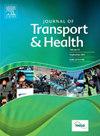Examining healthcare access with physical vs. telehealth options: Promise and peril for socially vulnerable older adults
IF 3.2
3区 工程技术
Q2 PUBLIC, ENVIRONMENTAL & OCCUPATIONAL HEALTH
引用次数: 0
Abstract
Introduction
This paper seeks to understand barriers to healthcare access faced by socially vulnerable older adults in Chicago using qualitative analysis. As the U.S. population ages, ease of healthcare access by older adults grows in importance. Yet, current literature lacks an examination of pain points and coping strategies in accessing healthcare, specifically by socially vulnerable older adults. This is especially relevant as virtual telehealth access and transportation options that shape healthcare access evolve rapidly.
Methods
In this work, we conduct three listening sessions with 40 total participants to understand the lived experiences of Black and Latino older adults living in low-income areas of Chicago. Transcript data was analyzed using qualitative concept and emotion coding to identify vulnerabilities that older patients face in accessing care.
Results
This work highlights five key takeaways from the qualitative analysis: 1) technology struggles and prospects in accessing healthcare, 2) social resources for coping give rise to tension between dependence and autonomy, 3) system disconnects (medical-pharmacy-transportation) represent key pain points, 4) different means of accessing healthcare (traditional transportation vs. telehealth) are value and emotion ladened, 5) different means of observing lead to new methodological insights.
Conclusion
Overcoming healthcare access barriers for older adults ultimately requires analysis of specific interfaces between infrastructure, healthcare, and communications systems. Solutions should prioritize the autonomy of older adults by offering physical accessibility and customized technology. The three intervention policies recommended in this paper include: health kiosks implementation, digital access classes, and specialized training for transit drivers and medical staff.
研究实体医疗与远程医疗的选择:社会弱势老年人的希望与危险
引言 本文旨在通过定性分析了解芝加哥社会弱势老年人在获得医疗保健服务方面所面临的障碍。随着美国人口的老龄化,老年人获得医疗保健服务的便利性日益重要。然而,目前的文献缺乏对获取医疗服务过程中的痛点和应对策略的研究,特别是社会弱势老年人。在这项工作中,我们进行了三次倾听会,共有 40 人参加,以了解居住在芝加哥低收入地区的黑人和拉丁裔老年人的生活经历。我们使用定性概念和情感编码对记录数据进行了分析,以确定老年患者在获得医疗服务时所面临的脆弱性。结果这项工作强调了定性分析中的五个主要启示:1)获得医疗服务时的技术挣扎和前景;2)应对问题的社会资源导致了依赖性和自主性之间的紧张关系;3)系统脱节(医疗-药物-交通)是关键痛点;4)获得医疗服务的不同方式(传统交通与远程医疗)在价值和情感上都有影响。结论要克服老年人获得医疗保健的障碍,最终需要对基础设施、医疗保健和通信系统之间的具体接口进行分析。解决方案应优先考虑老年人的自主性,提供实际的无障碍环境和定制技术。本文建议的三项干预政策包括:实施健康信息亭、开设数字无障碍课程以及对公交司机和医务人员进行专门培训。
本文章由计算机程序翻译,如有差异,请以英文原文为准。
求助全文
约1分钟内获得全文
求助全文

 求助内容:
求助内容: 应助结果提醒方式:
应助结果提醒方式:


